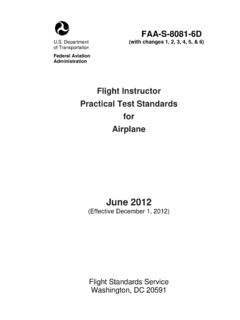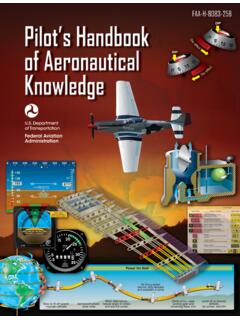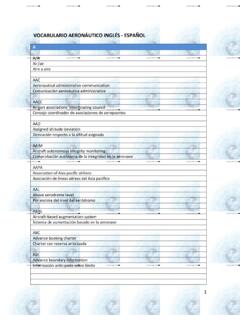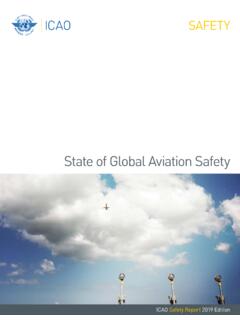Transcription of Appendix 1 Runway Incursion Avoidance - FAASafety.gov
1 1-1 IntroductionRunway safety is a significant challenge and a top priority for everyone in aviation. In the United States, an average of three Runway incursions occur daily. Each of these incidents have the potential to cause significant damage to both persons and property. Runway incursions are a serious safety concern and have involved air carrier aircraft, military aircraft, general aviation (GA), and pedestrian vehicles. [Figure 1-1] Several Runway incursions have resulted in collisions and fatalities. Fatalities have occurred at both towered and nontowered airports. A few seconds of inattention can cause a Runway Incursion . Runway Incursion AvoidanceAppendix 11-2 Figure 1-1.
2 Runway incursions are a top FAA safety concern that involves pilots, air traffic control (ATC), and ground operations. You are expected to taxi an airplane safely whether moving to or from a Runway or otherwise moving about the airport. Scenarios such as bad weather, low visibility, construction, airport unfamiliarity, time of day, distractions, fatigue, and miscommunications with air traffic control (ATC) add greatly to the challenge of surface navigation. This chapter is designed to help you attain an understanding of the risks associated with surface navigation and is intended to provide you with basic information regarding the safe operation of aircraft at towered and nontowered airports.
3 This chapter focuses on the following major areas: Runway Incursion overview Taxi route planning Taxi procedures Communications Airport signs, markings and lightingEach section identifies best practices to help you avoid errors that may potentially lead to Runway incursions . Although the chapter pertains mostly to surface movements for single-pilot operations, all of the information is relevant for flight crew operations as well. Additional information about surface operations is available through the following sources: Federal Aviation Administration (FAA) Runway Safety website FAA National Aeronautical Navigation Services (AeroNav), formerly known as the National Aeronautical Charting Office (NACO) Airport/Facility Directory (A/FD) Automatic Terminal Information Service (ATIS) Notice to Airmen (NOTAMs) Advisory Circular (AC) 91-73, part 91 and part 135, Single-Pilot and Flight School Procedures During Taxi Operations Aeronautical Information Manual (AIM)
4 AC 120-74, parts 91, 121, 125, and 135, Flight Crew Procedures During Taxi Operations Runway Incursion OverviewApproximately three Runway incursions occur each day at towered airports within the United States. The potential that these numbers present for a catastrophic accident is unacceptable. A Runway Incursion is formally defined by the FAA as any occurrence at an aerodrome involving the incorrect presence of an aircraft, vehicle, or person on the protected area of a surface designated for the landing and takeoff of aircraft. The following are examples of pilot deviations, operational incidents (OI), and vehicle (driver) deviations that may lead to Runway incursions .
5 Pilot Deviations: Crossing a Runway hold marking without clearance from ATC Taking off without clearance Landing without clearance Operational Incidents (OI): Clearing an aircraft onto a Runway while another aircraft is landing on the same Runway Issuing a takeoff clearance while the Runway is occupied by another aircraft or vehicle Vehicle (Driver) Deviations: Crossing a Runway hold marking without ATC clearance According to FAA data, approximately 65 percent of all Runway incursions are caused by pilots. Additionally, 75 percent of the 65 percent of Runway incursions are caused by GA Factors of Runway IncursionsDetailed investigations of Runway incursions over the past 10 years have identified three major areas contributing to these events: Failure to comply with ATC instructions1-3 Figure 1-2.
6 Heads-up, eyes 1-3. Relocated threshold. Lack of airport familiarity Nonconformance with standard operating procedures Clear, concise, and effective pilot/controller communication is paramount to safe airport surface operations. You must fully understand and comply with all ATC instructions. It is mandatory to read back all Runway hold short instructions on an unfamiliar airport can be very challenging, especially during hours of darkness or low visibility. Ensure you have a current airport diagram, remain heads-up with eyes outside, and devote your entire attention to surface navigation per ATC clearance. All checklists should be completed while the aircraft is stopped.
7 There is no place for non-essential chatter or other activities while maintaining vigilance during taxi. [Figure 1-2] Runway ConfusionRunway confusion is a subset of Runway incursions and often results in you unintentionally taking off or landing on a taxiway or wrong Runway . Generally, you are unaware of the mistake until after it has occurred. In August 2006, the flight crew of a commercial regional jet was cleared for takeoff on Runway 22 but mistakenly lined up and departed on Runway 26, a much shorter Runway . As a result, the aircraft crashed off the end of the Runway . Causal Factors of Runway ConfusionThere are three major factors that increase the risk of Runway confusion and can lead to a wrong Runway departure: Airport complexity Close proximity of Runway thresholds Joint use of a Runway as a taxiwayNot only can airport complexity contribute to a Runway Incursion ; it can also play a significant role in Runway confusion.
8 If you are operating at an unfamiliar airport and need assistance in executing the taxi clearance, do not hesitate to ask ATC for help. Always carry a current airport diagram and trace or highlight your taxi route to the departure Runway prior to leaving the you are operating from an airport with Runway thresholds in close proximity to one another, exercise extreme caution when taking the Runway . Figure 1-3 shows a perfect example of a taxiway leading to a Runway and a Runway with a displaced threshold. If departing on Runway 36, ensure that you set your aircraft heading bug to 360 , and align your aircraft to the Runway heading to avoid departing from the wrong Runway .
9 Before adding power, make one last instrument scan to ensure the aircraft heading and Runway heading are , 08 MAR 2012 to 05 APR 2012NC-3, 08 MAR 2012 to 05 APR 2012 Figure 1-4. Taxi route planning helps to make airport surface movement certain circumstances, it may be necessary to use a Runway as a taxiway. For example, during airport construction some taxiways may be closed requiring re-routing of traffic onto runways. In other cases, departing traffic may be required to back taxi on the Runway in order to utilize the full Runway length. It is important to remain extremely cautious and maintain situational awareness (SA). When instructed to use a Runway as a taxiway, do not become confused and take off on the Runway you are using as a taxiway.
10 Taxi Route PlanningThorough planning is essential for safe taxi operations. Give as much attention to planning the airport surface movement as is given to other phases of flight. [Figure 1-4]Notices to Airmen (NOTAMs)Time-critical aeronautical information, which is of a temporary nature or not sufficiently known in advance to permit publication, on aeronautical charts or in other operational publications receives immediate dissemination by the NOTAM system. The NOTAM information could affect your decision to make the flight. It includes such information as taxiway and Runway closures, construction, communications, changes in status of navigational aids, and other information essential to planned en route, terminal, or landing operations.














